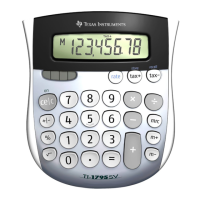[6.42] stdDev() and variance() find sample (not population) statistics
The variance and standard deviation statistics measure the deviation of data about the mean. If the
data consists of the entire population of n elements, the statistics are
Population standard deviation: , where is the population mean
✤ =
✟
i=1
n
x
i
−✙
2
n
✙
Population variance:
✤
2
Sample standard deviation: , where x
m
is the sample mean
s =
✟
i=1
n
x
i
−x
m
2
n−1
Sample variance:
s
2
For example, suppose I have the data {5,5,6,7,8,9}. Then = 1.4907 and s = 1.6330.
✤
The built-in command OneVar calculates both the population and sample standard deviations,
however, only the sample standard deviation (called Sx) is displayed with the ShowStat command. To
display the population standard deviation (called σx) after using OneVar, you must manually recall σx
as follows:
TI-89: [DIAMOND] [ ( ] [alpha] [S] [x] [ENTER]
TI-92+: [2ND] [G] [S] [x] [ENTER]
The stdDev() and variance() functions of the 89/92+ return the sample statistics, not the population
statistics. However, these functions can be used to calculate the population statistics if the results are
multiplied by a suitable correction factor:
and
✤ = s
n−1
n
✤
2
= s
2
n−1
n
which can be written as
and
✤ = s1−
1
n
✤
2
= s
2
1 −
1
n
so that n is referenced only once, instead of twice; this slightly simplifies the calculation. The correction
factor is found by equating the equivalent expressions for σ and s. Let
SS
x
=
✟
i=1
n
x
i
− m
2
where m is either the population mean or the sample mean, then
and or then
✤
2
=
SS
x
n
s
2
=
SS
x
n−1
SS
x
= s
2
$
(
n − 1
)
6 - 75

